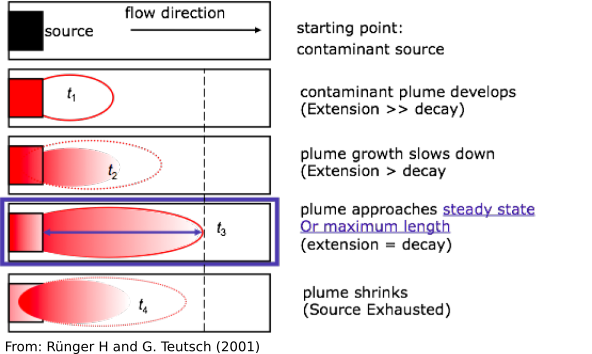Development of Contaminated Plumes
The spread of contaminant as it enters the flowing groundwater results to the formation of contaminant plume. The dimensions of contaminant plume can be used as a indicator for contaminated site assessment. Of particular interest thus can be the length of contaminant plume, which is explained in the figure below.

Several chemical reactions (or decay) occurs as contaminant is flown (extended) by the water from the source. Initially, as the extension<<decay, the plume grows and extends at the maximum speed. Subsequently, the extension slows down as the decay rate increases. With the source strength remaining intact, the maximum plume dimensions is reached when decay = extension or a steady-state condition. As source strength decreases, the plume shrinks and eventually is exhausted (the case: decay>>extension). Thus identification of steady-state and plume dimensions at that stage refers to worst-case scenario and these can be used as an indicator for the site assessment.
When steady-state remains for longer durations, which is often the cases for persistent pollutants (such as NAPLs), use of steady-state models that provide estimate of maximum plume length (\(L_{max}\)) can be used for site assessment.
This site provide tools for site-assessment based on stead-state models.
Reference:
Rünger H and G. Teutsch, 2001. Literature study, Natural attenuation of organic pollutants in groundwater, Integrated Concept for Groundwater Remediation (INCORE) -Final Report, Contract No.: EVK1-CT-1999-00017, Center of Applied Geosciences, University of Tübingen.